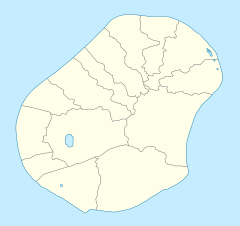 Tents and cots from the Nauru offshore processing facility in September 2012 | |
| Location | Meneng District, Nauru |
|---|---|
| Coordinates | 0°32′26″S 166°55′50″E / 0.54056°S 166.93056°E |
| Status | Open |
| Population | 1,233 (maximum, 2014); 0 confined after 2019 |
| Opened | 2001 |
| Managed by | Government of Nauru[1] |
| Country | Nauru |
The Nauru Regional Processing Centre is an offshore Australian immigration detention facility in use from 2001 to 2008, from 2012 to 2019, and from September 2021. It is located on the South Pacific island nation of Nauru and run by the Government of Nauru. The use of immigration detention facilities is part of a policy of mandatory detention in Australia.
The Nauru facility was opened in 2001 as part of the Howard government's Pacific Solution. The centre was suspended in 2008 to fulfil an election promise by the Rudd government, but was reopened in August 2012 by the Gillard government after a large increase in the number of maritime arrivals by asylum seekers[2] and pressure from the Abbott opposition.[3] Current Coalition and Labor Party policy states that because all detainees attempted to reach Australia by boat, they will never be settled in Australia,[4] even though many of the asylum seekers detained on the island have been assessed as genuine refugees.[5]
The highest population at the centre was 1,233 detainees in August 2014. A number of detainees have since been returned to their countries of origin, including Iraq and Iran.[5]
By November 2018, some refugees from Nauru (430 in total from both offshore facilities) had been resettled in the United States, but hopes of the United States taking more had faded. Although New Zealand had repeatedly offered to take 150 per year, the Australian Government refused. There were still 23 children on the island, as the government had bowed to public pressure and started removing families with children, after reports of suicidal behaviour and resignation syndrome had emerged.[6]
In February 2019, the last four children on the island (of an original 200 in detention on Nauru in 2013) were resettled in the United States with their families.[7] By 31 March 2019, there were no people held in the detention centre, which had been closed;[8] however as of March 2020, there were 211 refugees and asylum seekers remaining on the island.[9] As of 13 June 2020, a father and son were the last family left on Nauru; there was one single woman and the remaining people were single men.[10]
In 2020, over 100 men from Manus and Nauru were being detained in a hotel in Brisbane, after being transferred to the mainland for medical treatment. They were confined to quarters under a lockdown during the COVID-19 pandemic, and eventually released into the community in February 2021.
In September 2021 the Australian Government signed a new deal with Nauru to keep an ongoing form of asylum seeker processing centre on the island. There were around 107 asylum seekers remaining on Nauru as of July 2021.
The detainees at the centre have suffered serious human rights abuses and there are widespread reports of suicide and psychiatric illness.
- ^ "The Australian government does not run the Nauru Regional Processing Centre, or RPC. It is managed by the government of Nauru, under Nauruan law, with support from the Australian government." https://www.aph.gov.au/parliamentary_business/committees/senate/regional_processing_nauru/regional_processing_nauru/Final%20Report/c02 Archived 11 August 2020 at the Wayback Machine
- ^ Medhora, Shalailah (6 November 2015). "Julia Gillard defends hardline asylum seeker policy in al-Jazeera interview". The Guardian. Archived from the original on 29 April 2019. Retrieved 5 January 2019.
- ^ "Tony Abbott pushes for Nauru asylum seeker option on visit to island". news.com.au. HeraldSun,AAP. 12 June 2011. Archived from the original on 6 August 2011. Retrieved 21 October 2017.
- ^ Phillips, Janet (28 February 2014). "A comparison of Coalition and Labor government asylum policies in Australia since 2001". Parliament of Australia. Archived from the original on 13 September 2019. Retrieved 27 September 2019.
- ^ a b "Australia's offshore processing of asylum seekers in Nauru and PNG: a quick guide to statistics and resources". Parliament of Australia. 19 December 2016. Archived from the original on 21 December 2018. Retrieved 5 January 2019.
- ^ Amin, Mridula; Kwai, Isabella (5 November 2018). "The Nauru Experience: Zero-Tolerance Immigration and Suicidal Children". New York Times. Archived from the original on 1 February 2019. Retrieved 5 January 2019.
- ^ "Final four children held on Nauru to be resettled with their families in US". The Guardian. 3 February 2019. Archived from the original on 14 February 2019. Retrieved 14 February 2019.
- ^ "Operation Sovereign Borders monthly update: March 2019 - Australian Border Force Newsroom". newsroom.abf.gov.au. Archived from the original on 14 August 2020. Retrieved 4 May 2019.
- ^ Cite error: The named reference
Armbruster 2020was invoked but never defined (see the help page). - ^ Ryan, Hannah (13 June 2020). "The last family on Nauru" (text + podcast). The Saturday Paper. Archived from the original on 3 July 2020. Retrieved 2 July 2020. Podcast only Archived 2 July 2020 at the Wayback Machine
